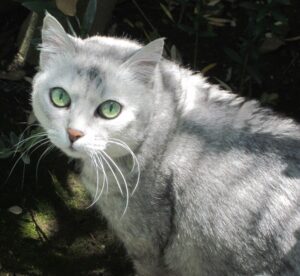Barks Blog
Feline Behavior Unmasked: Why Cats Paw at Water
By Tabitha Kucera

Q: Why does my cat paw at the water in her bowl prior to drinking it?
A: Pawing at, playing with or even splashing in a water dish is not as strange for cats as you might think. There are multiple reasons that may be motivating your cat to do this.
Cats’ whiskers are very sensitive because they are filled with sensory collecting nerves that collect information about objects, vibrations, and wind currents around the cat. Some cats may become uncomfortable when their whiskers are regularly being squished and brushed up against food and water bowls. To avoid this discomfort, some cats may paw at their water and drink from their paw instead.
Giving your cat the choice of a wide and shallow bowl may help accommodate your cat’s long whiskers. If they have a preference, they will let you know.
Water is a resource that all cats need, and resources need to be easily accessible in an area with an entrance and exit. Cats are both prey and predator animals and because of this, they are always on the lookout for predators that may attack them. When water is placed, for example, up against a wall where a cat would have to have his back to the room in order to drink, it can leave him feeling very vulnerable. Many cats will choose to paw at the water so they can be more aware of their surroundings and not have to put their head down. We have even seen cats attempt to move the bowl to an area where they have better visibility of what is around them. This is especially important to note in multi-cat households—you want to provide multiple areas for water. When placing water bowls, think more like a cat!
Also, when choosing a place for water bowls, many cats do not like them placed right next to their food. In the wild, cats go out of their way to keep their food and water sources separate to avoid having the food contaminate the water.
Cats instinctively seek out water that is moving instead of stagnant. From an evolutionary development standpoint, this may be because stagnant water is more likely to have bacteria and other harmful substances, so they prefer running water. If your cat enjoys drinking from the faucet or often paws at the water prior to taking a drink, offering him a water fountain is a good idea. Remember, with any resource, it’s always a good idea to provide your cat with choices and variety. Also, when a cat’s water is not filled at a consistent depth, he will commonly paw at the water to test the depth. Ideally, keep the water level consistent. Cats love routine and consistency.
Cats love to play and have fun and sometimes they get bored or are not provided with outlets to play, so they will create their own games like pawing or spilling their water. It is important for you to spend time with your cat and give him outlets to play. As mentioned earlier, food puzzle toys, daily play times with the owner (using a wand toy), interactive toys, rotating toys, and teaching your cat a fun new trick are great places to start.
In addition to all these recommendations, remember to always provide your cats with variety and choice and see what they like best. Lastly, don’t forget to keep the bowls clean and always have fresh water provided.
For further assistance with feline behavior issues, see
PPG Feline Resources: https://petprofessionalguild.com/Feline-Resources,
or find your closest feline behavior professional: https://petprofessionalguild.com/Find-Your-Feline-Professional
Resources
Garber, P, & Miller, F. (2017, November). Clicker Training for Cats, BARKS from the Guild (27) 16-23. Available at: https://issuu.com/petprofessionalguild/docs/bftg_nov_2017_online_edition_opt_1/16
About the Author
Tabitha Kucera is the owner of Chirrups and Chatter cat behavior consulting and training in Cleveland, Ohio. She is a certified cat behavior consultant through the International Association of Behavior Consultants, a registered veterinary technician and is low stress handling and fear free certified. She the co-chair of PPG’s Feline Committee and is the president elect of the Society of Veterinary Behavior Technicians.
